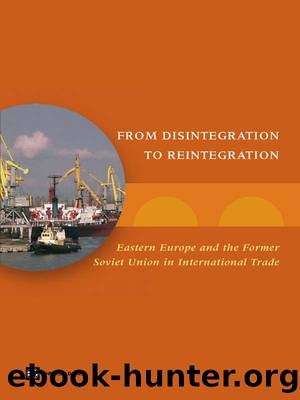From Disintegration to Reintegration by The World Bank

Author:The World Bank
Language: eng
Format: epub
ISBN: 9780821361979
Publisher: The International Bank for Reconstruction and Development / The World Bank
In-Country Barriers to Exit: âSoft Budget Constraintsâ
Worldwide, âsoft budget constraintsâ are the main mechanism through which unviable firms remain in the market.12 There is abundant evidence over the course of the Regionâs transition suggesting that soft budget constraints impede the exit of money-losing firms from the Region.13 Through greater fiscal and financial discipline (âhardeningâ of budget constraints), failing or value-subtracting firms in the Region have faced incentives to restructure or exit the market. The more difficult it is for such firms to go out of business, the less likely it is that the domestic market structure is competitive or that resources are allocated efficiently. Value-subtracting firms tie up productive assets, and in this way their presence deters entry of new business start-ups, distorts resource allocation, and constrains firm performance, including integration into the international market-place. Here, we investigate soft budgets arising from two factors: (i) arrears in taxes, wages and social payments, utility payments, and payables to input suppliers and (ii) subsidies.
Recent survey data indicate that the incidence of arrears is greatest among firms in Central Asia and other CIS countries, although firms elsewhere in the Region also face this problem. Box 4.1 illustrates such a case involving an SEE firm in Republika Srpska. Across firms of different ownership forms, arrears are lowest among firms with significant private ownership, including those that are integrated internationallyâthat is, foreign-invested businesses. Significantly, there is evidence for the Region that in the countries where arrears are larger, the export performance (measured by the share of exports in GDP) is lower (see figure 4.6). This reaffirms the direct linkage between behind-the-border conditions and success in international integration among the countries in the Region: where there is a lack of domestic competition, firmsâ abilities to penetrate foreign markets are dulled.
Box 4.1 Arrears as Constraints on Firm Performance in SEE
The case of a large furniture manufacturer in Republika Srpska provides an illustration of how a poor business climate can hinder exports. Labor regulations and unresolved ownership status are the key factors affecting the performance of the firm in question. The company carries on its books 550 employees, of whom only 150â250 actually work. The company has been in arrears with pension contributions since 2000, which makes its workers ineligible for retirement. Moreover, political constraints prevent the company from laying off employees. There is little hope that the company will be privatized, as its total debt exceeds the market value of its assets by more than 50 percent. The company is in debt to the state, the IFC, and a commercial bank. Moreover, it has wage arrears and owes money to its suppliers. Currently, a large portion of its transactions take the form of barter. The unresolved labor situation leads to a vicious cycle: keeping the waitlisted workers on the books raises the arrears vis-Ã -vis the state and thus decreases the chances of privatization taking place. While the companyâs experience and reputation would allow it to receive additional orders from large multinationals, such as IKEA, fulfilling such orders is not possible because of a lack of working capital.
Download
This site does not store any files on its server. We only index and link to content provided by other sites. Please contact the content providers to delete copyright contents if any and email us, we'll remove relevant links or contents immediately.
| Administration & Medicine Economics | Allied Health Professions |
| Basic Sciences | Dentistry |
| History | Medical Informatics |
| Medicine | Nursing |
| Pharmacology | Psychology |
| Research | Veterinary Medicine |
Periodization Training for Sports by Tudor Bompa(7947)
Why We Sleep: Unlocking the Power of Sleep and Dreams by Matthew Walker(6391)
Paper Towns by Green John(4826)
The Immortal Life of Henrietta Lacks by Rebecca Skloot(4274)
The Sports Rules Book by Human Kinetics(4099)
Dynamic Alignment Through Imagery by Eric Franklin(3936)
ACSM's Complete Guide to Fitness & Health by ACSM(3835)
Kaplan MCAT Organic Chemistry Review: Created for MCAT 2015 (Kaplan Test Prep) by Kaplan(3815)
Introduction to Kinesiology by Shirl J. Hoffman(3634)
Livewired by David Eagleman(3547)
The River of Consciousness by Oliver Sacks(3431)
The Death of the Heart by Elizabeth Bowen(3355)
Alchemy and Alchemists by C. J. S. Thompson(3313)
Descartes' Error by Antonio Damasio(3170)
Bad Pharma by Ben Goldacre(3118)
The Gene: An Intimate History by Siddhartha Mukherjee(2942)
The Emperor of All Maladies: A Biography of Cancer by Siddhartha Mukherjee(2942)
The Fate of Rome: Climate, Disease, and the End of an Empire (The Princeton History of the Ancient World) by Kyle Harper(2894)
Kaplan MCAT Behavioral Sciences Review: Created for MCAT 2015 (Kaplan Test Prep) by Kaplan(2832)
